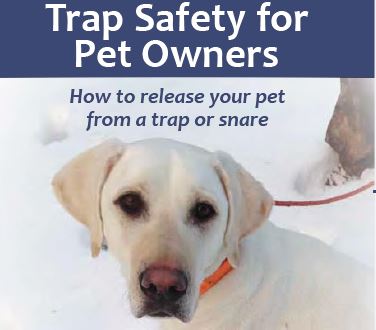
The Alaska Department of Fish and Game’s wildlife conservation division and the Alaska Trappers Association have produced a brochure for pet owners. (Image from ADFG)
The state’s Board of Game Sunday voted down proposals to require ID tags or signs around traps and snares in Southeast Alaska. The board was split on one of the proposals that was intended to help with enforcement of trapping regulations and to address problems of pets getting caught in traps.
Prior to 2016 trappers in this part of the state were required to have signs marking their trap lines or tags on each trap or snare with a trapper’s name and address or an identification number. The board voted to remove that requirement three years ago because of the burden it puts on trappers.
A proposal this year sought to reinstate the requirement. Alaska Trappers Association president Randy Zarnke opposed the change.
“One of the arguments we hear routinely is that law enforcement when they discover traps or snares set illegally they need that tag, that ID tag to know who the trapper is and I’ve talked to a lot of enforcement people around the state, at least in the Fairbanks area and the other places I’ve talked to the enforcement people, they know who traps where and they’ve got it pretty well mapped out,” Zarnke said, adding, “sometimes literally with maps on the wall and names and they don’t need that. They’ve got that part of it figured out.”
Zarnke thought signs near trap lines should be optional but not required. Other trappers testified the tags would be a financial burden and would be misused by people opposed to animal snaring.
Written comments came in on both sides of the debate. Supporters of tags argued they would help with safety for pets and other non-targeted animals snared near recreational trails. Opponents argued the tagged snares could be relocated and used to frame a law-abiding trapper.
Kim Titus of Juneau is a retired biologist and supervisor with the Alaska Department of Fish and Game. He supported tags for traps and snares in his community.
“I’ve personally observed right behind the community garden a dead bear in a snare, 50 yards behind the community garden right near the Juneau hunter education facility, with snares set around it and a dead bear there,” Titus said. “I turned it over to Fish and Game and the troopers and everything and I really don’t know whatever happened but I was still employed at the time so I didn’t take it to the press or take my photos to the press of the dead, decomposed bear in a snare. It was a wolf snare I presume, right behind the community garden.”
Fish and Game and the Alaska Wildlife Troopers were both neutral on the proposal. The troopers’ Lieutenant Aaron Frenzel said in remote areas of the state law enforcement doesn’t have problems identifying trappers. But he said there were issues in more populated parts of the state.
“Having a trap tag will allow us to contact people, hold people accountable for leaving stuff out,” Frenzel said. “These aren’t typically our ethical trappers that are doing this, it’s the unethical ones, the sloppy trappers that aren’t taking good counts of what gear they’re putting in the field and not getting it all out.”
The board was split on the issue. Tom Lamal of Fairbanks said he would support the requirement after having a dog caught in a snare on his property behind his house.
“If that snare or trap had a tag on it, I could have called the kid, I’m sure it was a young kid doing it, and told him this is probably not the best way to do this and you need to contact the Alaska Trappers Association, find out where you can do this stuff,” Lamal said. “And I never would have reported this, we never reported this to the troopers. Another neighbor his dog lost a leg, another neighbor his dog got killed. And there’s a large area down below us where the trappers quit trapping because they could see it was such a public use area. So they basically policed themselves, which was great. But not everybody’s responsible.”
However, trapper and board vice chair Nate Turner of Nenana opposed the change.
“I think it’s possible for the troopers to determine who’s setting a trap in a bad spot or an illegal spot, or even out of season, simply by setting up a trail camera in some cases, if they come back for it,” Turner said. “If it was an abandoned trap that was probably in some cases accidentally left or forgotten, or something, I don’t know. I think it’s not impossible to catch people that are doing things in inappropriate areas, especially in urban interfaces.”
Turner and board chair Ted Spraker of Soldotna are both members of the trappers’ association. The proposal failed on a 4-2 vote with only Lamal and Larry Van Daele of Kodiak supporting it. There was also a proposal to require signs marking both ends of a trap line. That was voted down unanimously.











